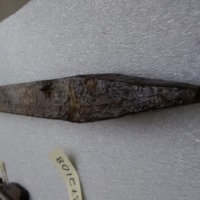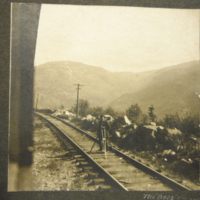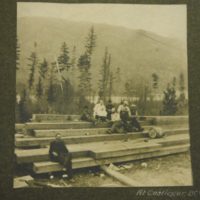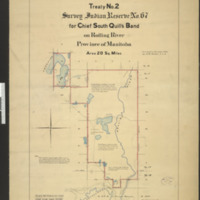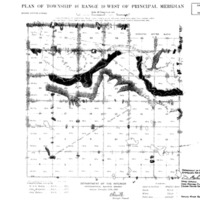My Artifact
My Artifact – Provenance, History, and Key Actors
Artifact Description and General Provenance
This artifact is a long iron post, used as a survey marker in Manitoba. Acquired by the Canada Science and Technology Museum on November 11th, 1973, the post is 151.7 centimeters in height, 3.7 centimeters wide, and has a length of 4.2 centimeters. It has been extensively affected by rusting. Its base is defined by a sharp point at the end, which was undoubtedly used for pushing it into the ground at the location where it was placed. At the top of the post, we notice a flat, square end. Just under this, one of the inscriptions '16 19 W,' '16 18 W', '17 18 W' and '17 19 W' is engraved into each edge.[1]
The post was placed to demonstrate the location of a “township corner” during a Dominion Lands survey. In particular, it was “placed at [the] northeast corner of Section 36, Township 16, Range 19, West of Principal Meridian on [the] east boundary of Rolling River Indian Reserve No. 67, Manitoba.”[2] As has been mentioned in the contextual background, the Dominion Lands survey program was designed to prepare Canadian lands acquired from the Hudson’s Bay Company for settlement. Demarcating townships was therefore instrumental in organizing the territory according to expected settlement.
While this technical background reveals some key information about this survey marker, our interaction with its provenance can be diversified much further by an exploration of the individuals who played a role in giving it historical meaning.
In light of the context of the Dominion Lands Survey and the place of Manitoba and the North-West in its narrative, the two individuals associated with this monument, John McLatchie and R.W. Clark, are of particular interest. McLatchie is noted to have placed the post in its original location during a Dominion survey at Rolling River in 1873. Clark retrieved the item in 1953, putting in its place an updated marker.[3] Both figures are central to our knowledge of this symbolic artifact.
R.W. Clark – The Story of a Collector
Ralph William Clark was a figure who worked as a land surveyor from 1934 to 1956. Born in 1907, Clark enjoyed a diverse and illustrious career. He is especially noted for his passionate approach to the collecting of surveying artifacts.[4] He was responsible for the establishment of the 'Canadian Landmarks' collection in 1952[5], from which this Rolling River marker is taken. The temporal closeness between the creation of this program and the retrieving of this artifact is also interesting.
Clark died in 1970[6], but the role he played in our understanding and appreciation of Canadian surveying has continued up to the present day. His collection helps to emphasize the physical, tangible dimensions of the Dominion Land Survey, which complements our study of the more abstract historical dimensions of its significance within Canadian history.
John McLatchie – The Story of a Nineteenth-Century Surveyor
John McLatchie participated directly in the explosion of land surveying by the Canadian government in the early 1870s. He placed the iron township marker within Township 16 of Rolling River in 1873, as part of a larger survey plan of numerous regions in the newly federated Manitoba. His place of origin is West Templeton, Quebec, where he was born in 1842.[7]
McLatchie did not start out with large-scale surveys such as those under the Dominion Lands system; this, of course, was determined by the fact that no such institution existed until 1869.[8] In fact, upon becoming a P.L.S. (Provincial Land Surveyor) in 1864, he largely worked on timber limits surveys in the Ottawa region.[9] On paper, April 14th, 1872 was a day which radically transformed McLatchie’s career and his significance in Canadian history. It was on this day that he obtained the distinguished title of Dominion Land Surveyor (D.L.S.).[10] However, records of his surveying activity in townships 12, 13 and 14, “all west of the principal meridian”,[11] indicates that McLatchie was possibly involved in the survey of Western Canada before becoming a D.L.S.
McLatchie’s surveys of Townships 15 through 18 took place in 1872. In 1873 – the year of most significance for this artifact – he is confirmed to have done surveys of parts of the north and east “outlines” of townships 16 and 18[12], which is where the Rolling River region is to be found. Maps of Rolling River from later periods claim to draw information from such 1873 surveys, and are presented in the image gallery for this section.
The Canada Science and Technology notes that the iron-based style of the McLatchie marker is significant, given that the marking of corners of townships and sections with wood was normal until the emergence of the use of iron for this purpose in 1882. McLatchie’s iron post highlights the use of this material long before 1882. McLatchie, as it turns out, was a huge proponent of increased use of iron in survey markers.[13] The example of such campaigns cited by the museum are possibly located in the Canadian Sessional Papers of 1890, where consideration of his proposal was received positively. The replacing of wooden markers with iron markers made sense in these times and in this environment. The densely wooded North-West Territories were victimized by forest fires frequently, and these could destroy wooden markers; on the other hand, iron would remain intact after such disasters.[14]
Interestingly, A. F. Cotton, in an autobiographical text, recounts his experience with McLatchie while working as his assistant during McLatchie’s Manitoba survey in 1872. The narrative does not give many details, but it does reflect the harshness involved in voyaging across the continent, as seen in his claim that “travelling those days was no pleasure,” despite the trip taking place during the spring and early summer. As Cotton notes, the trip from Ottawa to Winnipeg during this time took an entire month to complete.[15]
Thus far, we have seen how the placer of this artifact, John McLatchie, has a story with connections to the Riel Rebellion of 1869. McLatchie’s surveying career would have no doubt been affected by the pause in Dominion Land surveying until 1871, and the creation of Manitoba in 1870 also likely had consequences. However, McLatchie was much more engaged with the second military confrontation between the Métis and the federal government: the Northwest Rebellion. He is known for his participation in Dennis’s Intelligence Corps during this conflict, being employed as a lieutenant.[16] In this case, the aforementioned conflict between the original inhabitants of Western Canada and the surveyors evaluating this land became explicit.
In his memoir, Cotton gives an account of his personal involvement in the precipitation of the Northwest Rebellion. This narrative illustrates a vivid sense of the serious conflict between the claims of First Nations groups and surveyors working for the Dominion of Canada. While the story is long, its significance for surveying history, its connection to McLatchie, and its themes of conflict make it relevant to the 1873 artifact:
"The second Riel Rebellion, breaking out in the spring of 1885, put all surveying out of the question. This rebellion is now history and has often been written about, at least most of the causes have been told, but not all. Here is one very few know anything about...
In 1884 my instructions informed me that I was likely to rub shoulders with Chief Picau and his outfit, and I was warned to be very careful. In August I found myself in the heart of what he claimed as his Reserve, that is north-west of Saddle Lake and south of White Fish Lake. I knew that Picau had been to Regina to see Lt. Governor Dewdney, who was also an Indian Commissioner. On his return he found me running Township outlines, and he was naturally wrathful, for he had secured the Lt-Governor's promise that no surveys would be made until his Reserve had been allotted to him. He and his tribe came to camp, and we had a three day pow-wow. He suggested that he and I go to Regina, and while we were gone his men would live at my camp. I refused to do so, and told him that I would not stop my work until forced to do so. Well, the next day he DID stop me. In my absence next day, the chief and a couple of his followers forcibly stopped the survey by folding up the instrument, and handing it to the transit-man. Nothing more happened, as I had told my men not to resist should the Indians show hostility. I went to Edmonton and wired Lt. Governor Dewdney. It took three weeks for a reply to reach me, and then all it said was: “Take Mounted Police if necessary”. I then went to Fort Saskatchewan and saw Inspector Greisbach. We decided that he and I go back to White Fish Lake and interview Chief Picau, which we did.
I know the Indian Commissioner never went to see Chief Picau or send anyone to quiet him until October, when it was too late. The seeds of rebellion had taken root. The Frog Lake massacre [on] April 2nd 1885, was the beginning of the rebellion, and it was instigated by the Indians with whom I had had the trouble." [17]
The 1870s and 1880s, despite being successful times for the future of Canadian Western settlement, were also filled with discontent among groups who resented foreign intrusion onto their land. As Cotton demonstrates, the 1885 Rebellion had its roots in these confrontations. This simple iron post thus takes on an intensely historical significance. This is illustrated through its connection to a surveyor who was present throughout the expansion of Canadian sovereignty to the West, as well as its indirect connections with the Riel Rebellions, which demonstrated a rigorous Métis opposition to the implications brought by the Dominion Lands System.
[1] Artifact information, Catalogue # 1973.0694.001. Canada Science and Technology Museum.
[2] Canada Science and Technology Museum, “Landmarks: Supplementary Information,” item # 12.
[3] “Landmarks: Supplementary Information,” item # 12.
[4] S & M News: Department of Energy, Mines and Resources, June/July 1970; No. 26: 11.
Saskatchewan Land Surveyor's Association, “Ralph William Clark,”https://www.slsa.sk.ca/biographies/086.php.
[5] Artifact information, Catalogue # 1973.0744.001. Canada Science and Technology Museum.
[6] Saskatchewan Land Surveyor's Association; S & M News, 11.
[7] Association of Ontario Land Surveyors, Annual Report of the Association of Ontario Land Surveyors and Proceedings of the Thirtieth Annual Meeting Since Incorporation, by Association of Ontario Land Surveyors 1922. Canada: 128.
[8] J. G. MacGregor, Vision of an Ordered Land: The Story of the Dominion Land Survey (Saskatoon: Western Producer Prairie Books, 1981), ix.
[9] Association of Ontario Land Surveyors, 128.
[10] Association of Ontario Land Surveyors, 128-9.
[11] Canada, Sessional Papers: Second Session of the Seventh Parliament of the Dominion of Canada (volume nine). J. S. Dennis. (A Short History of the Surveys Performed under the Dominion lands System, 1869 to 1889; print), 1892, 33 [part six].
[12] Association of Ontario Land Surveyors, 129.
[13] 1973.0694.001. Canada Science and Technology Museum.
[14] Canada, Sessional Papers: Fourth Session of the Sixth Parliament of the Dominion of Canada (volume eleven). J. S. Dennis. (Department of the Interior Technical Branch, Ottawa, 17th December, 1889.; print), 1890, 19 [part two].
[15] H. B. Cotton, “A Surveyor's Story: The Autobiography of Arthur Frederick Cotton,” British Columbia Historical News 23.3 (Summer 1996): 18.
[16] Association of Ontario Land Surveyors, 130.
[17] Cotton, 18-19.
